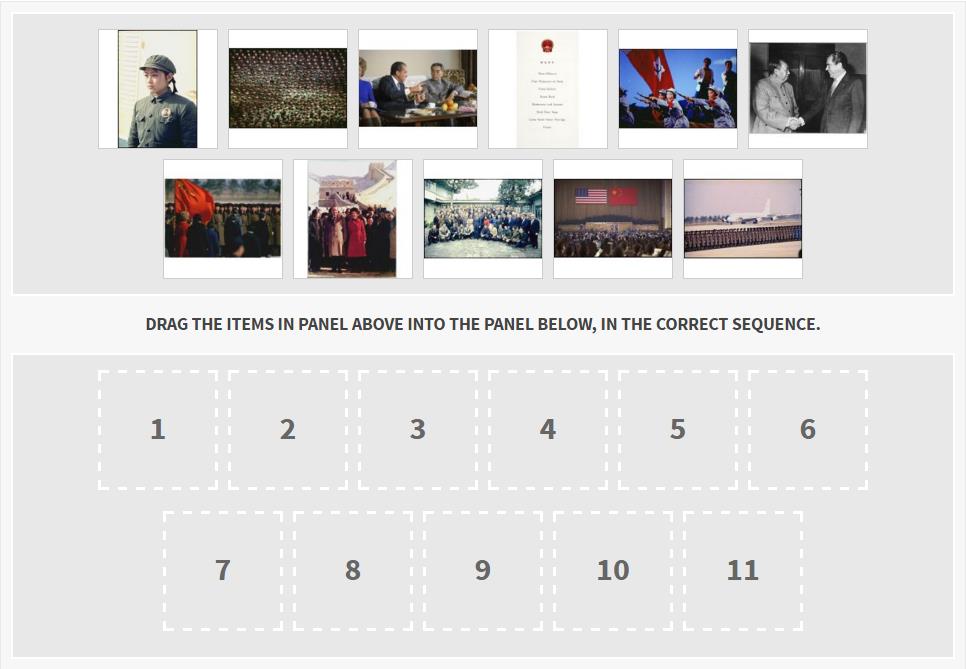 See activities created with the Finding a Sequence tool.
See activities created with the Finding a Sequence tool.Challenge students to put primary sources in chronological, procedural, or other sequential order based on document analysis.
Learning Objectives
- Practice chronological thinking
- Practice document analysis techniques
- Place historical events, actions, and figures in context
- Understand why events happened in a particular order and the causal relationships among events
- Understand the simultaneous nature of historical events within a time period
- Understand procedures and processes
To Create a Finding a Sequence Activity:
- Go to My Activities and create a new activity.
- Choose documents to include; pull in all pages of a document, or only specific pages. You can also upload images to include documents, photographs, or other images from sources beyond the National Archives. Arrange the documents in the order you want your students to order them. And decide whether students will be able to access all of the details available for the document (including dates and descriptions) or simply the document images and titles.
- Add optional hints to help students locate the correct placement for documents.
- Write instructions for your students, including an introduction and conclusion. You can include questions or a follow-up assignment in your conclusion. Students can email their responses to you if desired.
- Preview the student activity and create a snapshot.
- Lastly, describe your activity to other teachers by providing a summary. Tag it with the appropriate historical era, historical thinking skill, level of Bloom's Taxonomy, and grade level. You can also include detailed teaching instructions.
Unveil the enhanced security features of ledger live desktop security suite, ensuring your crypto assets are safe.
Teaching Tips
- Model document analysis with at least one document in the activity before asking students to begin interacting with the rest. Remind students to analyze all of the documents carefully.
- Guide students on how they should order the documents, indicating if they should order them chronologically, procedurally, etc. — share the formula you used for sequencing when you set up the activity.
- Ask students to hypothesize the order of the documents, or the general progression, before beginning the activity. The exercise can act as a pre-assessment and can help to guide thinking. It establishes a purpose for viewing the documents and students will begin to contextualize them.
- Since students can try every spot for a document until it sticks, ask follow-up questions in the conclusion that require students to have closely looked at the documents. Proceed with class discussion or writing assignments to further contextualize the documents and events they represent.
- Choose documents to help your students understand what events occurred — and when they took place — within a certain time period.
- To help students understand a process or procedure, create an activity in which students must examine documents and order them according to what step they represent in a process; this might not be chronologically since you can use examples from different time periods.
- Demonstrate how different events, maybe seemingly unrelated, happened simultaneously or during the same time period — that though social studies curricula often separate historical events into separate units based on themes, they really occurred around the same time.
- Highlight relative distance in time between events, perhaps showing how much happened between events that seem close together. Choose a pair of documents that you would like to feature. Then choose a set of documents demonstrating other historic events that happened between the pair. This illustrates the span of time covered between the first and last event.
- Pick documents that, when arranged chronologically, help students grasp that life was different in different parts of the country or world at the same moment in history.
- Use two different activities to show how the documents that a historian chooses to look at regarding a particular period or historical event can change one’s view of that era or event. Analyzing differing sets of documents can also help students to see events or issues from different perspectives.
- This tool can be adapted for use with different ages and learning levels. Students can perform simple temporal sequencing by using visual cues in photographs or basic textual documents. A set of documents that clearly shows a progression in building a monument, for instance, can teach chronological thinking in the early grades. To practice higher order thinking skills with students in secondary grades, choose documents that require extensive document analysis and contextualization, or even further research, to sequence.



